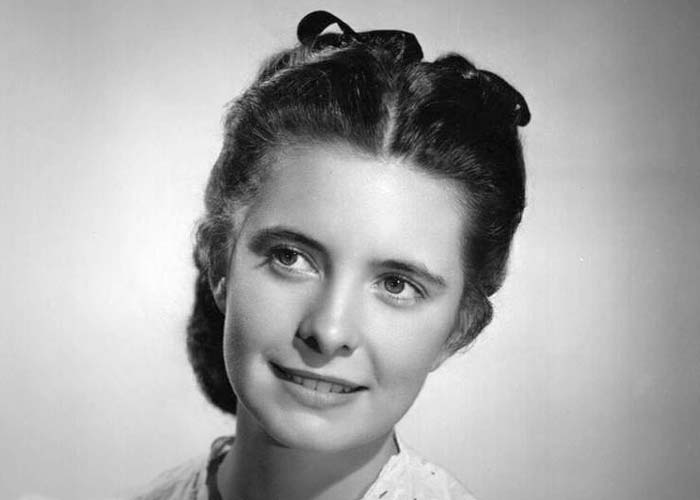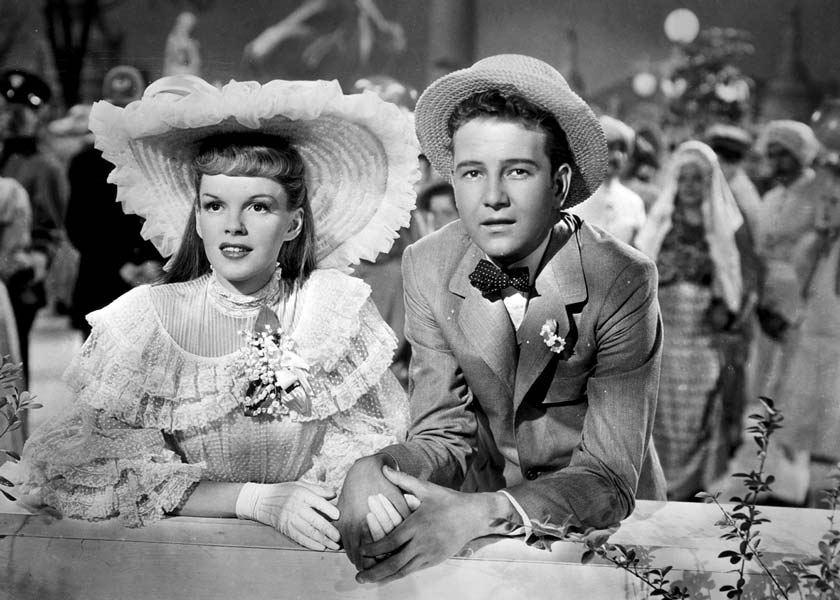Synopsis
A year in the life of the Smith family of St. Louis, Missouri, starts in the heat of summer, 1903. Esther Smith (Garland), sixteen years old, dreams about meeting John Truett (Drake), the boy next door. Rose (Bremer), Esther’s older sister, is expecting a call from Warren Sheffield (Robert Sully), her beau, who is at Yale. The only phone is in the dining room, and Rose will have to speak to Warren in front of her family. Esther tries to change dinner to an earlier time and her mother Anna (Astor) tells Alonzo (Ames), her husband, that to accommodate the maid they will have dinner early. However, he is tired and wants a bath and refuses to change dinner time. During dinner, the entire family listens quietly as Rose talks to Warren.
Later that evening, Rose invites John to a farewell party for their brother, Lon, Jr. (Henry H. Daniels, Jr.), who is leaving for Princeton. At the party, Esther and Tootie (O’Brien) entertain with a song and dance. After the party, Esther asks John to help her put out the lights. They flirt, but the shy John only shakes her hand as he leaves. Esther invites John to come with their friends to the fairgrounds being prepared for the St. Louis World's Fair.
Several days later, at the trolley station, Esther waits excitedly for John, but
the trolley starts, and she thinks he missed it. John boards just in time, and
Esther expresses her happiness by singing The Trolley Song.
At Halloween, Tootie and her older sister Agnes dress as goblins and go out to
join the other neighborhood children at a bonfire in the street. The children dare
Tootie to knock on the door of Mr. Braukoff, who everyone agrees is the scariest
man on the street. Tootie shakily goes up to the door and knocks. When Mr.
Braukoff answers, she throws flour on him and declares,
I hate you Mr Braukoff!
She runs off as Mr. Braukoff wipes himself off in
amusement. Tootie exalts and declares herself the most horrible.
Later,
Tootie comes home crying, bruised and cut. She claims that John hit her. She has a
bunch of hair in her hand. Esther storms over to John’s house and accuses him of
being a bully and beats and bites him. Later Tootie and Agnes confess the truth,
John saved them from being arrested after they nearly caused an accident on the
trolley tracks. Esther rushes back to apologize, and John accepts her apology,
pointing out where she bit him.
Later that evening, Lon, Sr., returns with the announcement that his firm is transferring him to New York City, and they will move in January. Lon is enthusiastic about his promotion and the move, but his family is upset and unhappy at the thought of leaving St. Louis. Anna, loyally, agrees that if he wants to move, they will move. As Lon and Anna celebrate their love and togetherness, the children accept the future move to New York that their father wishes.
On Christmas Eve, Rose is distressed because Warren has invited Lucille Ballad (June Lockhart), a visiting Easterner, to the Christmas dance. Lon, Jr., home for Christmas, is also perturbed; he wanted Lucille to go to the dance with him. With no one else to go with, Lon, Jr., and Rose end up going together, although they are not happy about it. Esther is upset because John will not be able to take her to the dance; he did not make it to the tailor’s in time to pick up his tuxedo. Esther goes with her grandfather (Harry Davenport). At the dance, Rose and Esther fill out Lucille’s dance card with the names of all the most boring and clumsy young men. The plan backfires when Lucille turns out to be sweet and understanding. She suggests that Rose pair with Warren, and she will partner with Lon, Jr. Esther cannot let Lucille dance with the men listed on the card, and she takes the dance card herself and bravely dances with all the dolts. Toward the end of the dance, John arrives and dances with her. In the garden under the moon, John and Esther kiss, and John proposes. He plans to leave college and get a job to support her. However, Esther realizes that they are too young to marry; he must finish college before marriage.
At home, Tootie rushes out to destroy the snow people she has made, crying that so no else will have them after the family moves to New York. Esther comforts her, and they look forward to Christmas. Lon, Sr., watching from the window, sees his daughters in the snow, and realizes how much they want to stay in St. Louis. He assembles his family and tells them that he has changed his mind, they will not move.
In the spring, the family, dressed in their finest, go to the Exposition. All the young couples are happy. Everyone is thrilled that the Exposition is in their own home town.
Discussion
Meet Me in St. Louis, a colorful musical that ranks among the finest films of the 1940s, is an almost perfect example of nostalgic turn of the century Americana. The lives of the Smith family in the year before the opening of the St. Louis World's Fair of 1904 are appealingly sweet and sentimental. Technicolor photography flatters the actors, especially the women in their colorful dresses, and enhances the beautiful settings. Director Vincente Minelli guides the production with special attention to achieving the ambience and charm of the period.
Judy Garland sings two songs that were immediate hits:
The Trolley Song
sung to Tom Drake and
Have Yourself a Merry Little Christmas
sung to Margaret O’Brien. Garland
also sings and dances the novelty song Under the Bamboo Tree
with O’Brien.
Leon Ames and Mary Astor, their voices dubbed, share the sentimental duet
You and I
. The fair’s own hit song,
Meet Me in St Louis, Louis,
written in 1904, is sung briefly by Garland and
Bremer and reprised throughout the movie. The turn of the century feeling is
further reinforced by several other period songs.
Meet Me in St. Louis presents an idyllic picture of a family, consisting of parents, a college-age son, two teenage daughters, two young daughters, and a grandfather. The sixteen-year-old Esther and the seven-year-old Tootie are the focus of the film. The concerns of the family members are simple and innocent. The love and comradeship of their parents model success in life. Alonzo Smith represents the upper middle class businessman who supports his contented family, including his wife’s father, in a modern, well-appointed home. The aspirations of the older sisters involve forming romantic relationships with young men. Esther dreams about the handsome and shy boy next door. Rose’s beau is in college. Lon, Jr., in his first year of college, also has a sweetheart. The yearnings of these young people are in keeping with the social standards of the time. The young women yearn for romance, a husband, and their own home. The young men, of the upper middle class, aspire to graduate from college and become lawyers or businessmen. After graduation, they will marry, buy a home, and start a family. The most serious event in their lives is the proposed move from St. Louis to New York.

Child star Margaret O’Brien has a whimsical demeanor, charm, bright eyes, and a pleasant, chirpy voice. An outstanding child actress, she had a large emotional range and was known for her ability to cry on demand. O’Brien had a highly successful debut, at age five, in Journey for Margaret, a film about the Blitz (Nazi Germany's bombing campaign against London in 1940-41). Under contract to MGM, she quickly became a major star and box office attraction in 1945 and 1946. O’Brien’s appealing and determined personality matched well with strong older actors such as Charles Laughton in The Canterville Ghost (1944), Edward G. Robinson in Our Vines Have Tender Grapes (1945), Wallace Beery in Bad Bascomb (1946), and Lionel Barrymore, Lewis Stone and Thomas Mitchell in Three Wise Fools (1946). Her final films at MGM were based on two well-known children’s books, Little Women and The Secret Garden, both released in 1949. By 1950 O’Brien was a teenager rather than an appealing moppet and audiences lost interest. She starred in only two more films, Her First Romance (1951) and Glory (1956). In adulthood, O'Brien played character roles in a few films but mostly continued her career on television where, for the next 65 years, she appeared in many series.
Margaret O’Brien’s popularity was at its zenith following the release of Meet Me in St. Louis, and she won one of only twelve Academy Juvenile Awards ever awarded (for outstanding child actress for 1944). Bob Hope, Master of Ceremonies at the Awards, playfully called the half-size juvenile statue an Oscarette. The statue was taken from O’Brien’s home in 1954 and disappeared for forty years. It was found at a Pasadena flea market in 1944 and returned to O'Brien.
The Louisiana Purchase Exposition, also known as the St. Louis World’s Fair, was held in 1904 to commemorate the centenary of the 1803 purchase, during the presidency of Thomas Jefferson, of the vast Louisiana territory stretching from the Mississippi River to the Rocky Mountains. St. Louis, situated at the confluence of the Missouri and Mississippi Rivers, is at the eastern boundary of this territory. One of the largest world’s fairs ever held, the grounds covered 1200 acres and included exhibits from 62 countries and 43 of the 45 states. The fair was a combination trade show, showplace of technological advances, and cultural monument to the Gilded Age. The last major international exhibition before World War I, the fair was a tribute to the peace, prosperity, and progress of the late 19th century world order.
Further Reading

